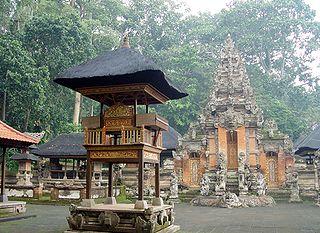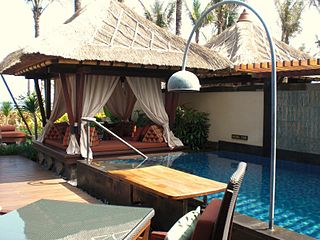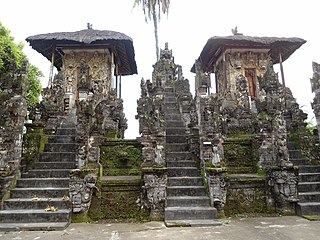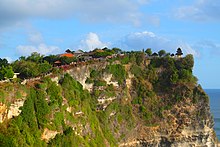
Besakih Temple is a pura complex in the village of Besakih on the slopes of Mount Agung in eastern Bali, Indonesia. It is the most important, largest, and holiest temple of Balinese Hinduism, and one of a series of Balinese temples. Perched nearly 1000 meters up the side of Gunung Agung, it is an extensive complex of 23 separate but related temples with the largest and most important being Pura Penataran Agung. The temple is built on six levels, terraced up the slope. The entrance is marked by a candi bentar, and beyond it, the Kori Agung is the gateway to the second courtyard.

Mandala Suci Wenara Wana, also known as Ubud Monkey Forest, is a sanctuary located in Padangtegal, Ubud, Bali, Indonesia.

Goa Gajah, or Elephant Cave, is located on the island of Bali near Ubud, in Indonesia. Built-in the 9th century, it served as a sanctuary.
Pura Gede Perancak is a prominent Hindu sea temple in Perancak, Bali, Indonesia. This temple commemorates the site of Dang Hyang Nirartha's arrival in Bali in 1546.

Pura Ulun Danu Beratan, or Pura Bratan, is a major Hindu Shaivite temple in Bali, Indonesia. The temple complex is on the shores of Lake Beratan in the mountains near Bedugul. The water from the lake serves the entire region in the outflow area; downstream there are many smaller water temples that are specific to each irrigation association (subak).

Pura Dalem Agung Padangtegal, or Padangtegal Great Temple of Death, is one of three Hindu temples making up a temple complex located in the Sacred Monkey Forest Sanctuary – commonly called the "Ubud Monkey Forest" – of Padangtegal, Ubud, Bali, Indonesia.

Pura Ulun Danu Batur is a Hindu Balinese temple located on the island of Bali, Indonesia. As one of the Pura Kahyangan Jagat, Pura Ulun Danu Batur is one of the most important temples in Bali which acted as the maintainer of harmony and stability of the entire island. Pura Ulun Danu Batur represents the direction of the North and is dedicated to the god Vishnu and the local goddess Dewi Danu, goddess of Lake Batur, the largest lake in Bali. Following the destruction of the original temple compound, the temple was relocated and rebuilt in 1926. The temple, along with 3 other sites in Bali, form the Cultural Landscape of Bali Province which was inscribed as a World Heritage Site by UNESCO in 2012.

Hyang is a representation of the supreme being, in ancient Java and Bali mythology. The spiritual entity can be either considered divine or ancestral. The reverence for this spiritual entity can be found in the folk religions of Java and Bali, such as the Sunda Wiwitan, Kejawen, Kapitayan, and Gama Tirta. The realm where Hyang resides is called the Kahyangan, which is an Old Javanese term that means "the abode of Hyang", "part of Hyang", or "heaven".

A Pura is a Balinese Hindu temple and the place of worship for adherents of Balinese Hinduism in Indonesia. Puras are built following rules, style, guidance, and rituals found in Balinese architecture. Most puras are found on the island of Bali, where Hinduism is the predominant religion; however many puras exist in other parts of Indonesia where significant numbers of Balinese people reside. Mother Temple of Besakih is the most important, largest, and holiest temple in Bali. Many Puras have been built in Bali, leading it to be titled "the Island of a Thousand Puras".

Pura Luhur Batukaru is a Hindu temple in Tabanan, Bali, Indonesia. Located on the southern slope of Mount Batukaru, Bali's second-highest volcano, the temple is one of nine kayangan jagat meant to protect Bali from evil spirits. Originally built during the 11th century, Pura Luhur Batukaru was dedicated to the ancestors of the rajas of Tabanan. It was destroyed in 1604, but rebuilt in 1959. The temple's most important shrine is a 7-tiered meru dedicated to Mahadewa, the God of Mount Batukaru.

Balinese architecture is a vernacular architecture tradition of Balinese people that inhabits the volcanic island of Bali, Indonesia. Balinese architecture is a centuries-old architectural tradition influenced by Balinese culture developed from Hindu influences through ancient Javanese intermediary, as well as pre-Hindu elements of native Balinese architecture.

Pura Meduwe Karang or Pura Maduwe Karang is a Balinese temple located in Kubutambahan, around 12 km east of Singaraja in Buleleng Regency, northern Bali. It is considered one of the principle temples of Bali, due to its size. Pura Meduwe Karang is noted for its statues and flowery style of decoration characteristic of North Bali.

Pura ParahyanganAgung Jagatkarta often referred to simply as Pura Parahyangan is a Hindu temple of Nusantara located in Ciapus village, Tamansari subdistrict, Bogor Regency, West Java, Indonesia.
Pura Lempuyang Luhur is the seventh and highest temple of the Lempuyang temple complex on Mount Lempuyang in Karangasem Regency, east Bali, Indonesia.

Pura Goa Lawah is a Balinese Hindu temple or a pura located in Klungkung, Bali, Indonesia. Pura Goa Lawah is often included among the Sad Kahyangan Jagad, or the "six sanctuaries of the world", the six holiest places of worship on Bali. Pura Goa Lawah is noted for being built around the opening of a cave which is inhabited by bats, hence its name, the Goa Lawah or "bat cave".
Pura Pulaki is a Balinese Hindu temple or a pura located to the west of Singaraja, Bali, Indonesia. The temple is set on flat land with rocky outcrops as the backdrop. Pura Pulaki is a pura segara or Balinese sea temples, set around the island to form a chain of temples which protect the island.

Pura Penataran Agung Lempuyang is a Balinese Hindu temple or pura on Mount Lempuyang in Karangasem Regency, Bali. It is the first and lowest temple of the complex of temples called Pura Lempuyang. The highest of these temples, Pura Lempuyang Luhur, is one of the Sad Kahyangan Jagad or "six sanctuaries of the world", six holiest places of worship on Bali, and one of the nine directional temples of Bali.

Pura Dalem Segara Madhu also known as Pura Dalem Jagaraga is a northern Balinese Hindu temple or pura located in the village of Jagaraga, Buleleng in northern Bali. It is about 11 km east of Singaraja. The village of Jagaraga is known historically as the place where the Dutch colonial government witnesses puputan or Balinese mass-suicide following their military attack on the kingdom of Bali in 1849. Pura Dalem Segara Madhu is known for its intensive wall decoration typical of northern Balinese architecture and for its unique western-influenced reliefs featuring early 20th-century airplanes and automobiles.

Pura Dasar Buana is a Balinese Hindu temple or pura located in Gelgel, Bali, about 3 kilometres (1.9 mi) from Semarapura. Pura Dasar Buana is one of the Pura Dang Kahyangan Jagat, a temple which was built to honor a holy teacher of Hindu teaching. Pura Dasar Buana honored Mpu Ghana, a Brahmin who arrived to Bali from Javanese Majapahit to teach Hinduism in the island.

Penglipuran is one of the traditional villages or kampung located in Bangli Regency, Bali Province, Indonesia. The village is famous as a tourist destinations in Bali because the villagers still preserve their traditional culture in their daily lives. The architecture of buildings and land processing still follow the concept of Tri Hita Karana, the philosophy of Balinese society regarding the balance of relations between God, humans and their environment. Penglipuran succeeded in building tourism that benefited all of its community without losing its culture and traditions. In 1995, Penglipuran also received a Kalpataru award from the Indonesian government for its efforts to protect the bamboo forest in their local ecosystem.



















